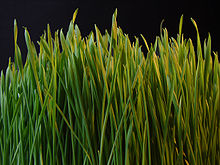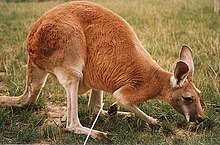Grass
From Wikipedia, the free encyclopedia
For other uses, see Grass (disambiguation).
Grasses, or more technically graminoids, are monocotyledonous, usually herbaceous plants with narrow leaves growing from the base. They include the "true grasses", of the family Poaceae (also called Gramineae), as well as the sedges (Cyperaceae) and the rushes (Juncaceae). The true grasses include cereals, bamboo and the grasses of lawns (turf) and grassland. Sedges include many wild marsh and grassland plants, and some cultivated ones such as water chestnut (Eleocharis dulcis) and papyrus sedge (Cyperus papyrus).
Uses for graminoids include food (as grain, sprouted grain, shoots or rhizomes), drink (beer, whisky, vodka), pasture for livestock, thatch, paper, fuel,clothing, insulation, construction, sports turf, basket weaving and many others.
Contents
[hide]Ecology
Graminoids include some of the most versatile plant life-forms. They became widespread toward the end of the Cretaceous period, and fossilized dinosaur dung (coprolites) have been found containing phytoliths of a variety that include grasses that are related to modern rice and bamboo.[1] Grasses have adapted to conditions in lush rain forests, dry deserts, cold mountains and even intertidal habitats, and are now the most widespread plant type; grass is a valuable source of food and energy for all sorts of wildlife and organics.
Graminoids are the dominant vegetation in many habitats, including grassland, salt-marsh, reedswamp and steppes. They also occur as a smaller part of the vegetation in almost every other terrestrial habitat.
Many types of animals eat grass as their main source of food, and are called graminivores – these include cattle, sheep, horses, rabbits and manyinvertebrates, such as grasshoppers and the caterpillars of many brown butterflies. Grasses are also eaten by omnivorous or even occasionally by primarily carnivorous animals. Grasses are unusual in that the meristem is locate near the bottom of the plant, hence can quickly recover from cropping at the top.[2]
In the study of ecological communities, herbaceous plants are divided into graminoids and forbs, which are herbaceous dicotyledons, mostly with broad leaves.
Agriculture
Plants of this type have always been important to humans. They have been grown as food for domesticated animals for up to 6,000 years. (See grass fed beef.) They have been used for paper-making since 2400 BC or before. The most important food crops are the grains of grasses such as wheat, rice and barley. They have many other uses, such as feeding animals, and for lawns. There are many minor uses, and grasses are familiar to most human cultures.
Lawns
Main article: Lawn
In some places, particularly in suburban areas, the maintenance of a grass lawn is a sign of a homeowner's responsibility to the overall appearance of their neighborhood. One work credits lawn maintenance to:
...the desire for upward mobility and its manifestation in the lawn. As Virginia Jenkins, author of The Lawn, put it quite bluntly, 'Upper middle-class Americans emulated aristocratic society with their own small, semi-rural estates.' In general, the lawn was one of the primary selling points of these new suburban homes, as it shifted social class designations from the equity and ubiquity of urban homes connected to the streets with the upper-middle class designation of a "healthy" green space and the status symbol that is the front lawn.[3][4]
Many municipalities and homeowner's associations have rules which require lawns to be maintained to certain specifications, sanctioning those who allow the grass to grow too long. In communities with drought problems, watering of lawns may be restricted to certain times of day or days of the week.[5]
The smell of the freshly cut grass is produced mainly by cis-3-Hexenal.[6]
Establishment of lawns
Lawns are established in 3 ways:
- Sowing grass seed blend on cleared soil - birds eat a lot of the seed
- Laying turf strips to create an instant lawn
- Regular mowing of mixed weeds - grasses survive this, almost nothing else does
Sports turf
See also: Turf management and Sand-based athletic fields
Grass is important in many sports, notably with those played on fields such as American football, Association football, baseball, cricket, and rugby. In some sports facilities, including indoor domes and other places where maintenance of a grass field would be difficult, grass may be replaced withartificial turf, a synthetic grass-like substitute. Sports such as golf, tennis and cricket are particularly dependent on the quality of the grass on which the sport is played.
Cricket
In cricket, the pitch is the strip of carefully mowed and rolled grass where the bowler bowls. In the days leading up to the match it is repeatedly mowed and rolled to produce a very hard, flat surface for the ball to bounce off. The quality of the preparation can have a considerable influence on the game; a relatively grassy pitch will favor bowlers and a hard and dryer pitch, with less grass remaining, will typically favor batsmen (at least initially). As the grass dries out and is damaged over the course of the match the pitch's characteristics will change, resulting in batting on the first day of a test match being vastly different to batting on the same pitch after several days of play.
Golf
Golf is very dependent on a quality grass surface. Grass on golf courses is kept in three distinct conditions: that of the rough, the fairway, and theputting green. Grass on the fairway is short and even, allowing the player to cleanly strike the ball. Playing from the rough is a disadvantage because the grass is generally much longer, which may affect the flight of the ball. Grass on the putting green is the shortest and most even, ideally allowing the ball to roll smoothly over the surface. An entire industry revolves around the development and marketing of grasses for golf courses.
Tennis
In tennis, grass is grown on very hard-packed soil, and the bounce of a tennis-ball may vary depending on the grass's health, how recently it has been mowed, and the wear and tear of recent play. The surface is softer than hard courts and clay (other tennis surfaces), so the ball bounces lower, and players must reach the ball faster resulting in a different style of play which may suit some players more than others. The most famous grass tennis court in the world is Centre Court at Wimbledon located in England, home of the Wimbledon Championship. This is considered the most expensive lawn in the world.
Fiction
Grass plays a central role in two important science fiction catastrophe novels from the 1940s and 1950s, Ward Moore's Greener Than You Think, in which the world is slowly taken over by unstoppable Bermuda Grass, and John Christopher's The Death of Grass, in which a plague that kills off all forms of grass threatens the survival of the human species.







No comments:
Post a Comment